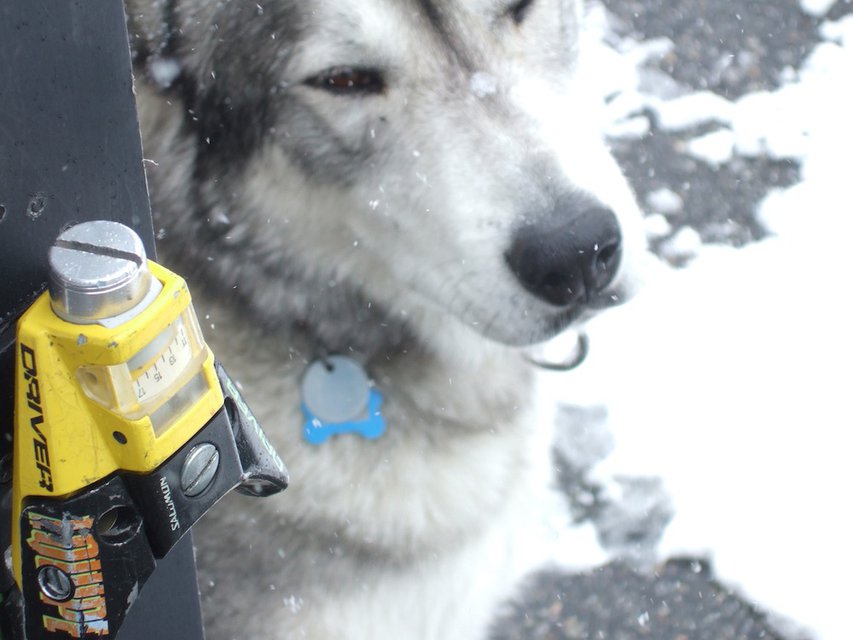
Words: The Jaded Local
I bought these for $60 and a sixer 10 odd years ago. When I acquired a pair of the rare and much-coveted Nordica W105′s soon after, the old 977′s seemed like the perfect match for the big black straightliners. Since then, I have skied several hundred days on them without a single release, pre or otherwise. Which has been awesome except for that time I blew my knee in 2008. But I’m 100 percent confident that it would have happened with any binding set on 13, so I’m giving them four stars for reliability.
I think this pair was made in ’87 or so. Who knows how many people have owned them over the years, or what happened to them before they came into my life, but judging by the amount of erosion they clearly had hundreds of days on them already. All steel, 11-17 DIN, AFDs worn away long ago?not exactly the formula for knee health. But 25 years later, I still trust these things with my everlasting soul, if not my ligaments, and that Salomon continues to make essentially the same binding regardless of the number they paint on the side now (currently 920).
That clanging snap when the heel piece closes is so reassuringly secure, but there’s an ominous finality there, too, like the two-stroke clack of a pump-action shotgun, or a jail cell door slamming shut. Locked, loaded, and safety most definitely off.
From the skid perspective, there are some distinct advantages beyond price point (about $75 for a pair with AFDs circa January). Durability,for one. Steel Salomons of any vintage are, for all intents and purposes, immortal. The only person I’ve heard of breaking one is Seth Morrison, landing a double front off a 150-foot cliff. And it is worth noting that the current distance jumping record on alpine gear was set by Rolf Wilson of Montana on?whattayaknow?a pair of vintage 977′s. Morrison aside, is there really a better indicator of overall integrity than stomping a 374-footer onto hardpack? Salomon doesn’t indemnify the 977 anymore (although the next generation is still good to go) and shops won’t work on them, but it’s good enough to give Rolf the calm serenity one presumably needs to send ‘er off the 90-meter.
Just like every Salomon with the traditional toe piece, you can manually raise or lower the toe height to accommodate the most worn-down boot soles (or in my case, hackwork vibram resole job), and then clamp that thing down tight to the ski (since you’re not coming out anyway), so it’s not rattling around in the toe piece, an unnerving side-effect of worn-down skid boots in some bindings.
Of course, all-metal bindings weigh a ton. Which doesn’t lend itself to a lot of impromptu daffies. But there is a perverse performance advantage from the extra heft: more weight keeping your skis from bouncing around, more mass slowing the rebound and keeping them tracking the direction on the snow. Which tends to encourage you to just let ‘em run, which leads to the next point:
While you might not release when you want to, you will never, ever just step out of this binding. Which is a good thing, because a ski with one of these things on it could really hurt you if it came off and then hit your face or something. And whatever you’re doing, if you’re at the point where a high-DIN binding makes any kind of sense, you probably don’t want to throw a shoe while you’re doing it, because then you’d be doing the same thing except on one ski, which will probably not be an existential improvement at that particular moment.
All that said, please don’t take any of this as a recommendation. In fact, I don’t recommend 25-year-old race stock bindings to anyone who doesn’t want to blow their knee. Because you will.
But if you’re living the life, sooner or later the green springs will find you. You’ll get a pair of big gnarly skis and then you’ll realize that you can’t put dinky little plastic bindings on them. And you’re broke. But there will be a pair of battered steel binders mounted on some old race skis at the thrift store, maybe even this very pair, and you’ll think to yourself, “Hey, these things are still solid, right? And I can just run ‘em on 11 or 12…”
The Final Score:
I’m giving the 977′s four stars for price, reliability, performance, and superior construction; three thumbs down for the might-rip-your-leg off factor, and a philosophical shrug because you’re probably going to end up skiing on them anyway. However, for a little more scratch, you can get a pair of the current 916′s which have the same heel, a lighter but solid toepiece, and a better DIN range that should be enough for everyone except Seth and Rolf, which is exactly what I did when I got a new pair of Big Boy Skis last year.

Comments